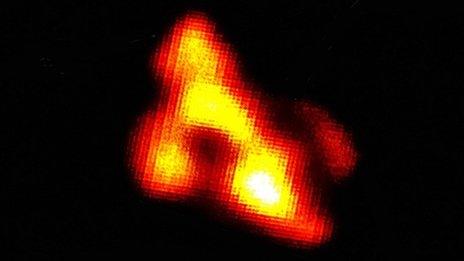German Rosat spacecraft re-entered over Bay of Bengal
- Published

Rosat (shown here) was photographed by a radar station in Germany
The tumbling German satellite Rosat re-entered the Earth's atmosphere over the Bay of Bengal, the German space agency (DLR) has confirmed.
This means any satellite components that survived the fiery plunge would have splashed into the ocean, avoiding populated areas.
Officials said Rosat re-entered the atmosphere at 0150 GMT on Sunday.
Experts had calculated that up to 1.6 tonnes of wreckage could have ridden out the destructive forces of re-entry.
This amounts to roughly half the spacecraft's initial mass.
Any Rosat wreckage had been strongly tipped to hit the ocean, given that so much of the Earth's surface is covered by water.
But two Chinese cities with millions of residents each, Chongqing and Chengdu, lay further north-east along the satellite's projected path, according to Jonathan McDowell of the Harvard-Smithsonian Center for Astrophysics in Cambridge, Massachusetts.
Just as for Nasa's Upper Atmosphere Research Satellite (Uars) satellite, which plunged through the atmosphere in September, there was high uncertainty about the final moments of Rosat.
In the case of Uars, the probable mass of surviving material was put at only half a tonne (out of a launch mass of more than six tonnes).
What made the redundant German craft's return interesting was that much more debris was expected to survive all the way to the Earth's surface.
The difference is due to some more robust components on the German space agency (DLR) satellite.
Rosat was launched in 1990 to survey the X-ray sky. It mapped more than 100,000 sources of this high-energy radiation. X-rays tend to come from the hottest and most violent parts of the cosmos, such as the regions around exploded stars and the "edges" of black holes. The mission was shut down in 1999.
The satellite had a mirror system made of a reinforced carbon composite material. This mirror complex and its support structure were expected to form the largest single fragment in what could have been a shower of some 30 pieces of debris to make it through to the surface.
Future spacecraft sent into orbit may have to meet stricter guidelines that limit the amount of debris likely to fall back on to the planet, but these rules are still some way from being introduced.
Tracking stations typically witness the uncontrolled return of at least one piece of space debris every day; and on average, one intact defunct spacecraft or old rocket body will come back into the atmosphere every week.
Something the size of Nasa's Uars satellite is seen to enter uncontrolled perhaps once a year.
- Published23 October 2011
- Published28 September 2011
- Published23 September 2011
- Published19 June 2011